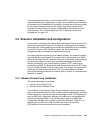
104 IBM Tivoli Remote Control Across Firewalls
The foregoing settings are mandatory and, once the installation is completed, all
this information is stored in the rcproxy.cfg file located at the Remote Control
Proxy installation directory. Inputs to modify the RC Controller Proxy
configuration file are given in “The rcproxy.cfg configuration file” on page 104.
3.3.2 Remote Control Proxy configuration
This section describes some of the configuration steps to modify the Remote
Control Proxy settings. The Remote Control Proxy configuration is done at
installation time and can be changed at any time by manipulating the following
configuration files:
Remote Control Proxy configuration file: rcproxy.cfg
Remote Control Proxy routing table: rcproxy.route
Remote Control policy method: rc_def_proxy
The rcproxy.cfg configuration file
The rcproxy.cfg file contains all the information related to the Remote Control
Proxy, such as Proxy type, ports used, Parent/Children/Relay information,
connection type, role, etc.
This file is located in the Remote Control Proxy installation directory that by
default is c:\Program File\Tivoli Systems\Remote Control Proxy on Windows
and /opt/Tivoli Systems/Remote Control Proxy on UNIX.
Example 3-5 shows the RC Target Proxy configuration file, based on the values
we provided in Table 3-1 on page 102, immediately after the installation process.
Example 3-5 Remote Control Target Proxy configuration file
[log]
log-file=rcproxy.log
debug-level=3
max-size=1
[rcproxy]
proxy-port=8888
proxy-type=Target
proxy-interface=tic01002
cmdline-port=9000
[communication-layer]
children-local-host=tic01002
children-local-port=2888
children-remote-list=tic01005+30008
children-cm-type=cm-tcp-unidirectional
buffer-size=1024
[children-cm-info]
connection-mode=client


















